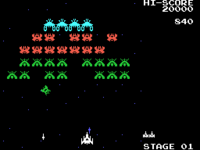Sega-Galaga
From Sega Retro
| Sega-Galaga | ||||||||||||||||||||
|---|---|---|---|---|---|---|---|---|---|---|---|---|---|---|---|---|---|---|---|---|
| System(s): SG-1000 | ||||||||||||||||||||
| Publisher: Sega Enterprises, Ltd. Samsung | ||||||||||||||||||||
| Developer: Sega Personal Computer Div.[1] | ||||||||||||||||||||
| Licensor: Namco | ||||||||||||||||||||
| Developer(s) of original games: Namco | ||||||||||||||||||||
| Genre: Shooting[2] | ||||||||||||||||||||
| Number of players: 1-2 (alternating) | ||||||||||||||||||||
| ||||||||||||||||||||
|
Sega-Galaga (セガ・ギャラガ) is the SG-1000 port of Galaga.
Contents
Gameplay
The game is a fixed shooter, similar to Space Invaders and its own predecessor Galaxian. The Galaga aliens fly into the screen in formation from the top and sides. The player controls a starfighter that can move horizontally along the bottom of the screen and must shoot down all of the alien forces to complete each stage. There is only one stage, which repeats until the player runs out of lives or decides to stop playing. The game has a two-player alternating mode.
Aliens can shoot projectiles at the player's ship, and the last aliens of a stage will dive at the ship. The ship is destroyed if it collides with an alien or its projectile, but it respawns after a moment if the player has extra lives remaining. The game starts with two extra lives, and extra lives are awarded for every 70,000 points earned.
Atop the enemy formation are four large aliens known as the "Boss Galaga," which take two shots to destroy. These aliens can use a tractor beam to steal the player's ship, which costs the player a life and gives the alien forces the ship to use as an additional enemy. If the player can destroy the alien controlling the ship without destroying the ship itself, the player can pilot both ships at once, doubling the firepower at the expense of being a bigger target.
The ship moves with ![]() and
and ![]() . It shoots with
. It shoots with ![]() , which can be held to fire continually, though it can be fired faster by pressing the button repeatedly.
, which can be held to fire continually, though it can be fired faster by pressing the button repeatedly.
Versions
Though Sega-Galaga is essentially the same game as the arcade original, the limitations of the SG-1000 means the graphics and sound are not quite as advanced. Also the "challenging stages" have been omitted, meaning each stage is identical to the last. It is the only port of the original arcade game to have its name changed.
Physical scans
SG-1000 version
| Sega Retro Average | ||||
|---|---|---|---|---|
|
| N/A | |
|---|---|
| Based on 0 reviews | |
| SG-1000, TW |
|---|
|
Master System version
Technical information
ROM dump status
| System | Hash | Size | Build Date | Source | Comments | |||||||||
|---|---|---|---|---|---|---|---|---|---|---|---|---|---|---|
| ? |
|
16kB | Cartridge (JP) | |||||||||||
| ? |
|
40kB | Cartridge (JP) | (Alt) | ||||||||||
| ? |
|
16kB | Cartridge (TW) |
References
NEC Retro has more information related to Galaga
|
- ↑ File:Sega Galaga SG-1000 JP Manual.pdf, page 6
- ↑ 2.0 2.1 https://sega.jp/history/hard/sc3000/software.html (Wayback Machine: 2020-09-28 02:34)
- ↑ Game Machine, "1986-05-01" (JP; 1986-05-01), page 6
| Sega-Galaga | |
|---|---|
|
Main page | Comparisons | Magazine articles | Reception | |
- 1-2 player games
- JP SG-1000 games
- All JP games
- TW SG-1000 games
- All TW games
- SG-1000 games
- 1984 SG-1000 games
- All 1984 games
- SG-1000 shoot-'em-up games
- All shoot-'em-up games
- KR Master System games
- All KR games
- Master System games
- Unknown year games
- Master System shoot-'em-up games
- All games
- No ratings
- Old technical information
- Sega-Galaga








